| By: Paul S. Cilwa | Viewed: 5/3/2024 Occurred: 2/27/2009 |
Page Views: 1282 | |
| Topics: #Camping #Hawaii #Maui #Photography #Places | |||
| All about the day I flew on my first trip to Hawaii. | |||
Maui, like all of Hawaii, has two seasons: Summer and Winter. Winter, which runs from October to April, is when most of the rain falls. But it's not a solid rain like some places get; it tends to come down in sudden light showers. And so, when I had a chance to fly to Maui, said by many to be the prettiest of the Hawaiian islands, even though it was in winter, I took it.
My flight was in two segments: from Phoenix to Los Angeles, and from there to Kahului, Maui's largest airport and the only one served by United. I got to fly first class on that second, longer segment (which meant I wasn't rubbing elbows with the person sitting next to me and I got to enjoy a spinach-mushroom omelet on the way).
I've been reading Mark Twain's Roughing It, an account of his days as an unsuccessful silver miner in Nevada in the 1860s, and brought it with me on this trip. Since I wasn't interested in the in-flight movie, I read it during the five-hour flight—and, to my astonishment (because it wasn't mentioned on the book jacket), Twain is hired by his newspaper to make a cruise to the Sandwich Islands—that is, to Hawaii! It felt so odd, almost as if Sam Clemens and I were making this trip together, albeit separated by 142 years.
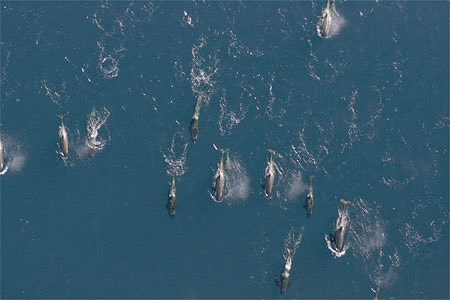
From the plane, as we were coming in for a landing, I saw a number of similarly-sized somethings in the water. I knew that winter is the time for the whale migrations past Maui, but I wasn't sure if these were whales or not until I saw one submerge.
That was cool!
As I got off the plane, I walked near two guys who had been traveling together. One announced, loudly, "I am so getting laid here!"
"I'm getting laid, too!" the second agreed. It wasn't until I saw them paying a couple of young women to put rings of flowers around their necks that they meant they were getting lei'd. At one time, all visitors to Hawaii got leis, flower necklaces, put on them. Now you have to pay for it, or be met by a friend or relative who does it, as I saw one woman being reunited with her sister from the mainland do.
Since I was not meeting anyone, I didn't get lei'd. But then, having been married for almost ten years, I've gotten used to that.
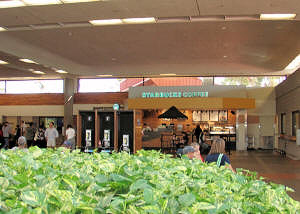
The Kahului Airport itself is literally cool, and breezy too, as it has few walls. Especially in the baggage department, the wind—which was 30 mph when I arrived—will take your hat off if you're not careful. There's a handy Starbucks where I got a Café Mocha to keep me awake while I waited for my rolling duffel. While drinking it, a gust of wind nearly took my hat and in trying to lunge for it I spilled Café Mocha all over my new Hawaiian shirt, my white slacks, and my sunglasses.
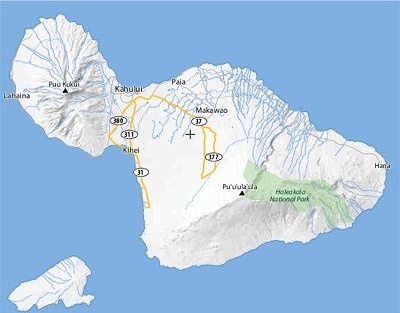
Maui is shaped sort of like an off-balance dumbbell. It was formed by two volcanoes that spilled enough lava to create an isthmus between them. The older volcano forms the Western Maui Mountains, a little over 5000 feet in elevation. I didn't get to explore them this trip. The newer volcano forms the larger, eastern part of Maui. It's known as Haleakala (hah-lee-AH-kah-la) and rises more than 10,000 feet above sea level. It's so large it creates Maui's weather, as moisture-laden sea air slams into it and is wrung out over the rain forests and heights of Haleakala's eastern, windward, side.
The isthmus between the volcanoes is almost entirely given over to sugar cane, so much so that there are no roads connected the southeastern part of the isthmus to the southwestern part. All roads lead to Kahului, and you wind up driving through that small city no matter where you really want to go.
On the other hand, for an island half the size of Rhode Island, that's not really as much of an inconvenience as it sounds.
Once I had my duffel, I met my Speedi Shuttle van which I had arranged to take me to the place where I was to rent my camper. There was a minor mix-up in which the Speedi Shuttle people were expecting me tomorrow. But they fixed it instantly and I was onboard the van in less than five minutes. (By the way, the van was pre-paid. I do like it when I don't have to worry about paying for things during the vacation.)
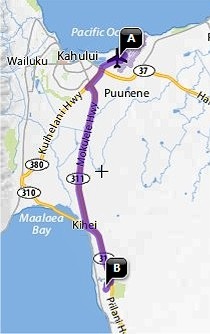
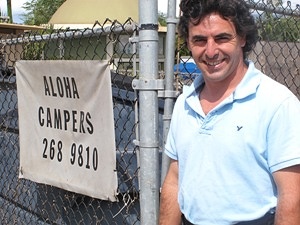
It was just a little over 12 miles from the airport to the town of Kihei and Aloha Campers, where Ariel, an Argentine transplant, rents VW campers to tourists. I could have paid for this one in advance as well, but saved 7% by paying him in cash, which I brought with me just for this purpose.
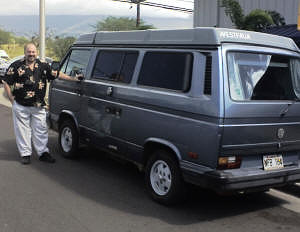
The camper he rented me has been well-used, but like most VWs is nearly indestructible. The unit he gave me had automatic shift. They don't all. The previous renter provided us with several minutes' entertainment as she struggled with her manual shift to emerge from the vehicle's parking space.
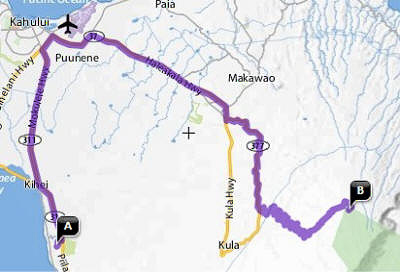
Now that I had the camper, I didn't spend a lot of time storing my gear, figuring I would do it later. I had brought my GPS and mounted it to the vehicle's windshield. Interestingly, it took almost five minutes for the unit to accept it had moved some 3000 miles while it was turned off. (It also turned out to not know much more about getting around on Maui than I did.) As soon as it had gathered its wits about it, I programmed it to lead me to my first destination: A campground located near the summit of Mount Haleakala. The route, of course, went by way of Kahului.
Kihei is right on Maui's South Shore and I quickly got my first view of "typical" Hawaii.
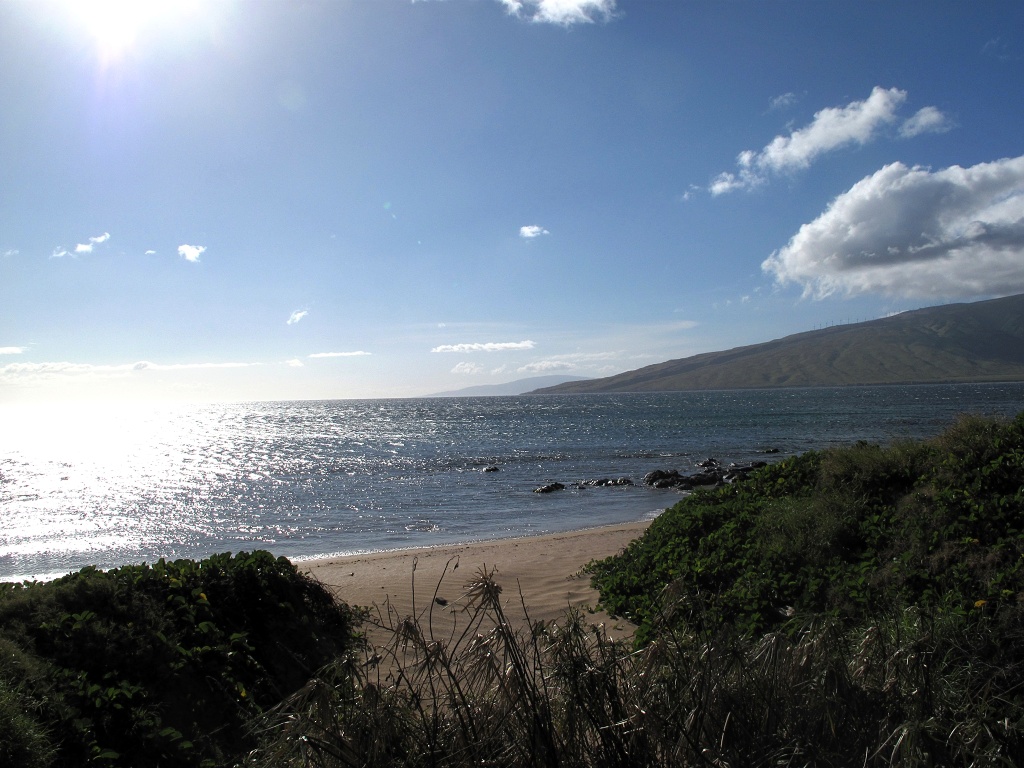
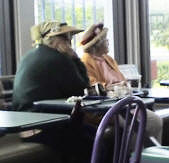
Since it was now lunchtime, I decided to grab a bite at McDonald's. A pair of lovely older women were there, enjoying a break today and each other's company. They were clearly native Hawaiian and decked out in their Sunday-go-to-meetin' best, including ornate hats that my mom would have loved to own and wear. I didn't get a good picture of the ladies—I didn't want to intrude—but I hope you can appreciate their hats.
Clothing in Hawaii is actually pretty silly, as the temperature year-round is ideal for the human being if unclothed—anything more is at least slightly uncomfortable. Remember, the missionaries came here intent on destroying Hawaiian culture just under two hundred years ago, in 1823. Mark Twain described those early days (and please forgive his use of diminutive terms for the native populations; taken as a whole it's clear he thought they were cool people but he was a man of his times, and those times believed it was White Man's "burden" to screw up all other peoples and cultures).
When the missionaries first took up their residence in Honolulu, the native women would pay their families frequent friendly visits, day by day, not even clothed with a blush. It was found a hard matter to convince them that this was rather indelicate. Finally the missionaries provided them with long, loose calico robes, and that ended the difficulty—for the women would troop through the town, stark naked, with their robes folded under their arms, march to the missionary houses and then proceed to dress!—
The natives soon manifested a strong proclivity for clothing, but it was shortly apparent that they only wanted it for grandeur. The missionaries imported a quantity of hats, bonnets, and other male and female wearing apparel, instituted a general distribution, and begged the people not to come to church naked, next Sunday, as usual. And they did not; but the national spirit of unselfishness led them to divide up with neighbors who were not at the distribution, and next Sabbath the poor preachers could hardly keep countenance before their vast congregations. In the midst of the reading of a hymn a brown, stately dame would sweep up the aisle with a world of airs, with nothing in the world on but a "stovepipe" hat and a pair of cheap gloves; another dame would follow, tricked out in a man's shirt, and nothing else; another one would enter with a flourish, with simply the sleeves of a bright calico dress tied around her waist and the rest of the garment dragging behind like a peacock's tail off duty; a stately "buck" Kanaka would stalk in with a woman's bonnet on, wrong side before—only this, and nothing more; after him would stride his fellow, with the legs of a pair of pantaloons tied around his neck, the rest of his person untrammeled; in his rear would come another gentleman simply gotten up in a fiery neck-tie and a striped vest.
The poor creatures were beaming with complacency and wholly unconscious of any absurdity in their appearance. They gazed at each other with happy admiration, and it was plain to see that the young girls were taking note of what each other had on, as naturally as if they had always lived in a land of Bibles and knew what churches were made for; here was the evidence of a dawning civilization. The spectacle which the congregation presented was so extraordinary and withal so moving, that the missionaries found it difficult to keep to the text and go on with the services; and by and by when the simple children of the sun began a general swapping of garments in open meeting and produced some irresistibly grotesque effects in the course of re-dressing, there was nothing for it but to cut the thing short with the benediction and dismiss the fantastic assemblage.
And thus, with the introduction of the weird invention of "clothing", we see the origin of the gaudy yet essentially useless article we call a "Hawaiian Shirt". —Which, incidentally, I never saw anyone wear in Maui who was not either a tourist, or working with the public in a tourist-oriented business (such as the shuttle driver).
I did notice that most men's hair was styled in a way popular on the mainland in the 1970s. This may be due to unceasing reruns of Magnum PI and Hawaii Five-0 on TV.
You might have noticed the word "Kanaka" in the above Twain quote. I asked a guy named Colin about this. Colin is part native Hawaiian and part surfer. The surfer part is winning. However, he told me about his uncles who were evicted from their land because they refused to pay taxes. "Why should we pay taxes to live in Hawai'i?" they asked. "We are Hawaiian!"
Colin takes a more pragmatic view. "I figure, if the United States didn't annex us, it would have been the French, or the Spanish, or the Japanese. It would have been someone. Hell, King Kamehameha wasn't Hawaiian; he came here from Tahiti and conquered the previous occupants. So we're just lucky to be owned by a country that's pretty decent."
I asked Colin if he knew anything about Hawaiian history and culture; it turns out that's a subject he'd taken in college. So then I asked about this word, "Kanaka", that Twain used to describe the natives here. In particular, I was concerned that it might be an impolite word.
"'Kanaka Maoli' means 'man of the land'," Colin told me. "It was our name for ourselves before the missionaries came. So it isn't inherently an insult, though of course any term can be used insultingly. Obviously, if you were to call me a 'stupid Kanaka' I would have to call you a 'stupid haole' back."
"'Haole'?" I asked.
"That's the word we use for ignorant foreigners. Well, these days it basically means 'white man'. But literally, it means 'a person without breath'."
"A dead person?" I asked, puzzled.
"No, 'ha' means breath. In the old days, when people met, instead of shaking hands they 'rubbed noses'—but they would actually smell each other's 'ha' or breath. That's what 'aloha' means. It's an acknowledgement of our interconnectedness, that we literally share the breath of the world and of each other. But foreigners didn't understand this custom and so seemed unspeakably rude to my ancestors. A 'haole' really means a person without breath, without manners, without soul."
I nodded. "That's very cool," I said. "It really says so much about the Hawaiian culture…and what a shame it was to have it so altered in the name of religion."
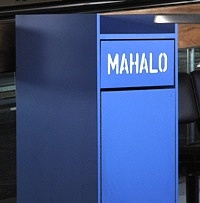
"And now it's being altered in the name of commercialism," Colin agreed. "'Mahalo' means thank you. But it's printed on all our trash cans. So a lot of visitors leave here thinking 'mahalo' means 'trash'!"
There are no Interstate Highways on Maui. There are highways, but they are old. One person complained that the highway system on Maui was 45-to-50 years out of date. The top speed allowed on sections I drove was 55 mph; in many places it was 20 mph or even 10 mph. And these speeds were not conservative; it was really about as fast as one could safely drive.
Once along on the Haleakala Highway, the road climbed steadily. It was deceptive, though; I knew I was gaining elevation but had no idea how much until I looked behind me.
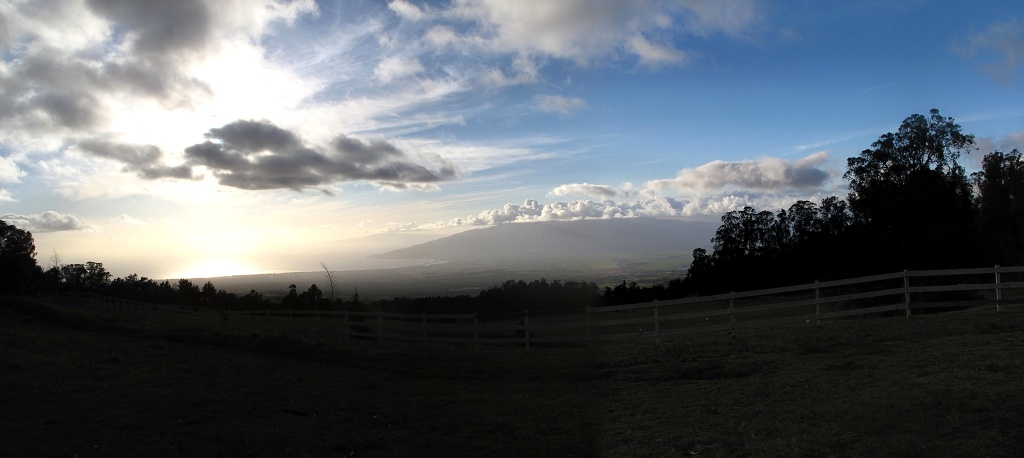
The isthmus was stretched out behind me and, behind it, were the West Maui Mountains. Here's another shot that shows more of the sugar cane fields in the isthmus.
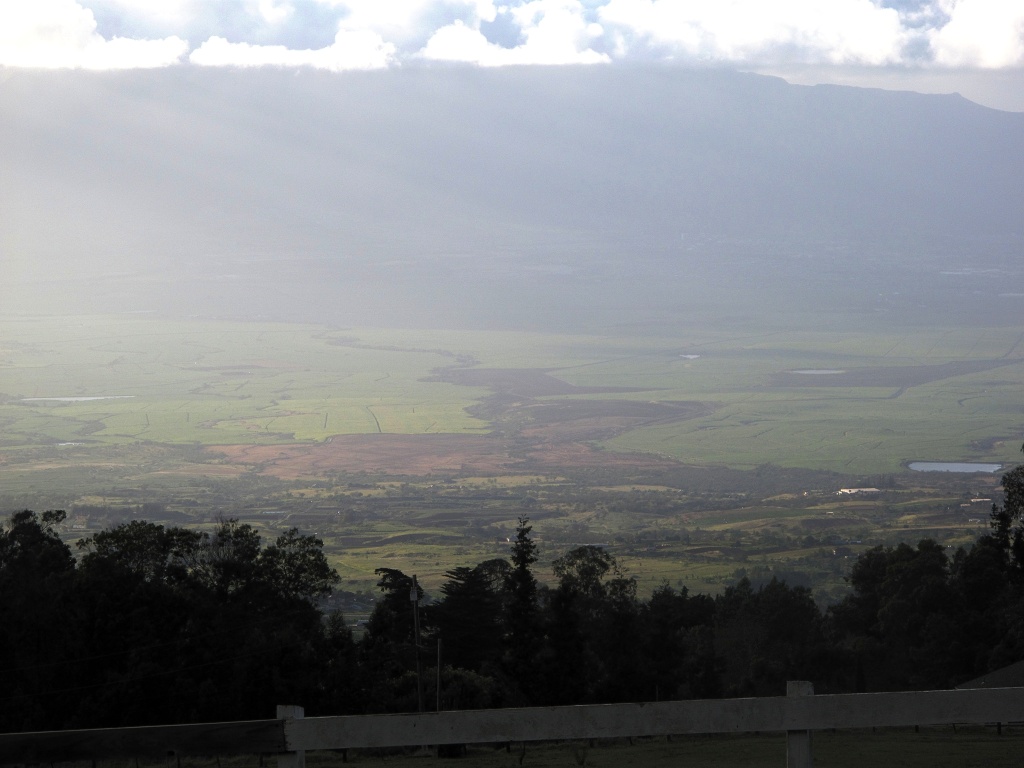
Ahead of me, the road zigzagged in determined switchbacks as it hugged the side of mighty Haleakala. There were many sections of what seemed to be unused fields, but also many villages with pleasant, middle-class homes and small stores.
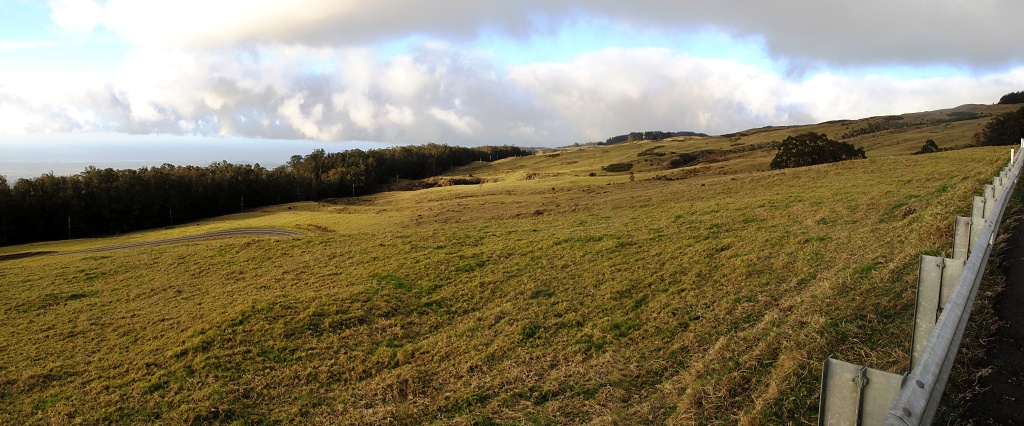
As I drove, periodic signs advised of my current altitude: 5000 feet, 6000 feet. Haleakala's summit is 10,063 feet. But it was just below the 7000 foot level that I came to the gate to Haleakala National Park. It was 6:03 pm, and the ranger had already left for the night. There was, however, a vending machine into which I could put $10 and receive in return a three-day pass to the park, which included camping privileges. So I did that, and put the receipt on my dashboard.
Just a mile or so further, and I came to Hosmer Grove Campground, my goal for the night.
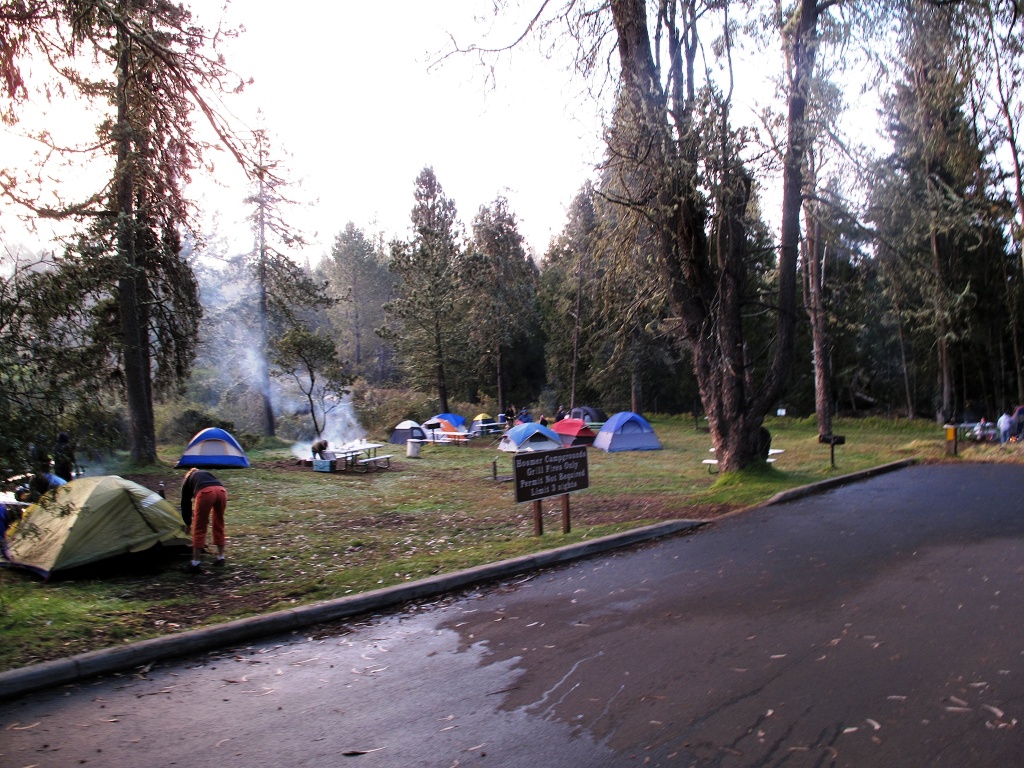
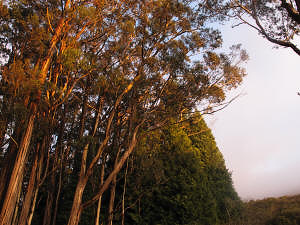
This campground is a first-come, first-served affair. Fortunately, in the camper, I didn't need to find room for a tent—I just needed a place to park, and I got the last parking space, conveniently located near the pit toilets.
Although the summit of Haleakala was still enshrouded by cloud, and spurts of rain continued to fall, the setting sun illuminated the trees that made up the campground's namesake grove. But it was now going on for 7 PM, 10 o'clock Phoenix time, and I had been up since 3 AM. I pulled out the sheets and blankets and pillows that came with the camper, and made the bed. I usually sleep nude, but the outside temperature was in the 30s and it wasn't much more than that inside the camper, so I kept on my jeans and flannel shirt. I wrapped one fleece blanket around my head and the other around my body, and fell asleep to the sound of increasingly insistent rainfall and occasional rocks of the camper by gales of high-altitude wind.





